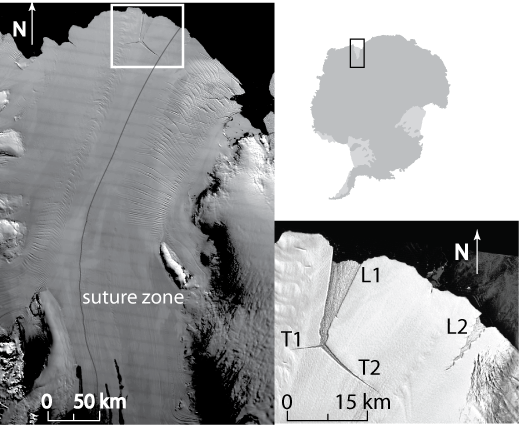What are ice shelf rifts?
Rifts, large fractures that penetrate the entire ice thickness, are precursors to iceberg calving events. These fractures can extend up to hundreds of kilometers and propagate for decades before becoming the detachment boundary of icebergs. Little is known about the forces and mechanisms that lead to rift initiation and propagation and hence iceberg calving, because we have very few measurements against which hypotheses can be tested.
What are we doing to understand rift propagation?
A fundamental question that needs to be addressed to develop models of iceberg calving is what forces are the primary drivers of rift propagation, e.g., what role do atmospheric winds, oceanographic tides or storm induced ocean swell play in driving rift propagation rates. To address this, I’ve been working with an international team of scientists to deploy global positioning system receivers (GPS) and seismometers around the tip of a propagating rift on the Amery Ice Shelf, East Antarctica. By comparing the timing of the bursts of rift propagation, deduced from sudden rift widening measured with our GPS coincident with swarms of seismicity detected with our seismometers, with winds from automatic weather stations and tides measured by our GPS along with other proxy data I showed that the timing of the bursts of propagation did not correspond to any extreme environmental effects. Order-of-magnitude calculations, combined with satellite observations of rift propagation rates provide further confidence in this result and indicate the magnitude of most environmental stresses is small compared to that the internal glaciologic stress.
Funded Research into Rift Propagation
We are now funded by NASA to extend this study to use satellite images (MODIS and MISR) to measure rift propagation rates for dozens of rifts on 5 different ice shelves. The goals of this study are to (i) determine what differences (if any) exist between different rifts on different ice shelves; (ii) if differences do exist, determine what variables control rift propagation rates (e.g., are differences related to atmospheric oceanic temperatures or due to the internal stress within the ice); (iii) compare measured rift propagation rates with linear elastic fracture mechanics derived propagation rates; (iv) incorporate rift propagation into an ice shelf model and predict how calving rates for different ice shelves will vary under different climate forcings. Depending on our success in predicting rift propagation rates and iceberg calving rates, our parameterization of rift propagation rates will be incorporated into the community ice sheet model (developed by our colleagues at the Los Alamos National Laboratory).
Undergraduate research in rift propagation
Scott Hall worked with me as an REU student over the summer measuring rift lengths and developing a finite element model of ice shelf flow. Robin Czerwinksi, an undergraduate in the Program in the Environment here at UM, is doing an honors thesis studying ice shelf rift propagation.
Publications related to calving and rift propagation
- Bassis, J.N., (2011), The statistical physics of iceberg calving and the emergence of universal calving laws, Journal of Glaciology, 57(2010), 3-16. Profiled
- Walter, F., S. O’Neel, D.E. McNamara, T. Pfeffer, J.N. Bassis and H.A. Fricker., (2010), Iceberg calving during transition from grounded to floating ice: Columbia Glacier, Alaska. Geophysical Research Letters, 37(15), L15501. (10.1029/2010GL043201.) Editors highlight
- D.R. MacAyeal, E.A. Okal, R. Aster and J.N. Bassis, (2009), Seismic Observations of Glaciogenic Ocean Waves (Micro-Tsunamis) on Icebergs and Ice Shelves, Journal of Glaciology, (55)190, 193-206
- Alley, R.B., I. Joughin, H.J. Horgan, T.K. Dupont, B.R. Parizek, S. Anandakrishan, K.M. Cuffey, J.N. Bassis, (2008), A Simple Law for Ice-Shelf Calving (2008), Science, Vol. 322. No. 5906, p. 1344.
- MacAyeal, D.R., E. Okal, R. Aster, J.N. Bassis, (2008), Seismic and Hydro-Acoustic Tremor Generated by Colliding Icebergs, Journal of Geophysical Research, 113, doi:10.1029/2008JF001005.
- Bassis, J.N., H.A. Fricker. R. Coleman, Y. Bock, J. Behrens, D. Darnell, M. Okal, J.B Minster, (2008), An Investigation Into the Forces that Drive Ice Shelf Rift Propagation, Journal of Glaciology. 184(54), 17-27. Profiled
- Bassis, J.N., H.A. Fricker, J.B, (2007), Seismicity and Deformation Associated with Ice Shelf Rift Propagation, Journal of Glaciology, 183(53), 523-536. Profiled
- MacAyeal, D.M., E. Okal, J.N. Bassis, et al., (2006), Transoceanic wave propagation links iceberg calving margins of Antarctica with storms in Tropics and Northern Hemisphere, Geophysical Research Letters, 33, doi:10.1029/2006GL027235.
- Fricker, H.A., N. W. Young, R. Coleman, J. N. Bassis, J.B. Minster, (2005), Multi-year monitoring of rift propagation on the Amery Ice Shelf, East Antarctica, Geophysical Research Letters, 32, L02502, doi:10.1029/2004GL021036.
- Bassis, J. N., R. Coleman, H. A. Fricker, J. B. Minster, (2005), Episodic propagation of a rift on the Amery Ice Shelf, East Antarctica, Geophysical Research Letters, 32, L06502, doi:10.1029/2004GL022048.
- Fricker H. A., J.N. Bassis, J.B. Minster, D. R. MacAyeal, (2005), ICESat’s new perspective on ice shelf rifts: The vertical dimension, Geophysical Reseach Letters, 32, L23S08, doi:10.1029/2005GL025070.

